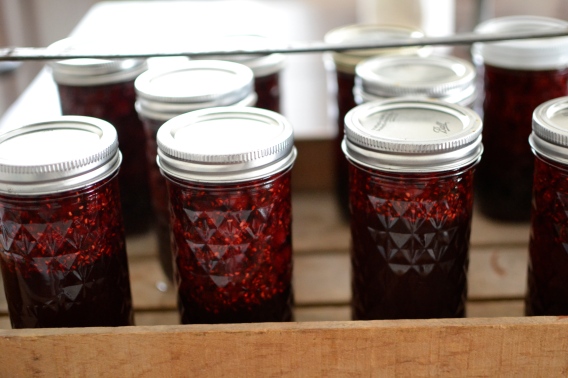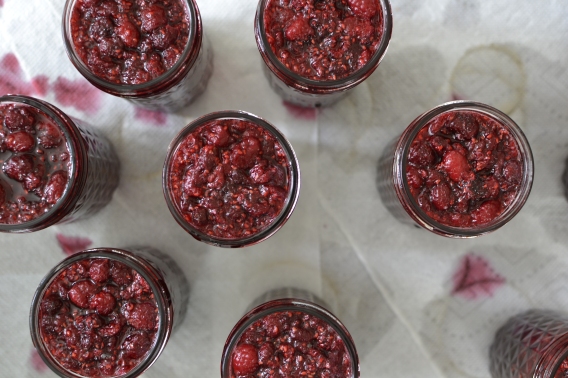I wrote this post ages and ages ago, whilst I was still at cookNscribble, but never published it for a variety of reasons. My life is currently in suspension (or so it seems) and I am living on a friend’s couch before going back to South Africa for nearly a month (having just been there to see my grandmother who is very frail) so everything is in storage and on hold slightly. This is to tide you over until I’m able to blog properly again…
When I was about 16, my family started to grow berries for export. We had always been mielies, potatoes, cabbages and wheat folk, but one summer we were suddenly also berry growers. Now, after spending several summers in England, watching people’s delight as raspberry and strawberry season unfolds, followed by blackberry season in the early autumn, I sort of understand what all the fuss is about. I love a wander and a forage as much as the next person. And I can even get into growing my own raspberries. But this is a good 15 years on from the “summer of the berries” (as it is collectively known by the cousins). That summer has taken on myth and legend in my family as a result. One just has to mention “the summer of the berries” to elicit a collective groan and much laughter. (Or as Tim so eloquently put on the Whatsapp conversation I started to jog their memories of that summer, “shit, do we really need to go there?”)
That summer, there was an abundance of blackberries and raspberries on the farm. Berries that didn’t make the export standard had to be used up – by us. So ensued: berry jam, berry pavlovas, berry trifle, berry alcohol, berry salads. Anything that could use a berry was made. And eaten. No one survived the summer untraumatised. None of us could stand to look at a berry by the end, let alone eat any. My cousin Jess still will not eat raspberries. I’ve spent years avoiding blackberries – it’s only recently that I have started to eat them again, and then only if I’m taking them off the plant myself and only a few at a time.
But raspberries I’ve sort of come around too. Not in vast quantities. I will never be the girl who eats a punnet surreptitiously in the kitchen when no one is watching. But the odd one or two, a smear of jam on toast, an Eton mess, I can get in to. I’ve started to, dare I confess it?, even like raspberries, particularly sun-drenched ones, still warm, eaten straight from the cane. So when the opportunity came up to go raspberry picking as part of my experience at cookNscribble, how could I say no? Perhaps I might finally be cured of that fateful summer of berries.
So it was that one day this summer we journeyed to the valley of Schoharie, where Molly’s friend Alexandra has a farm with about 20 rows of raspberries which she grows predominantly for preserves. That week, the canes were suddenly all loaded with ripe fruit. We spent a hot hour on a Tuesday afternoon picking gloriously red, pink, magenta raspberries. Then on the Wednesday morning, Ali and I spent another hour (the breeze making things ever so slightly cooler) picking several more baskets. By the end, we’d picked our way up a row, but we were dripping sweat, our hands stained with berry juice. Alexandra, who is French, floated through the rows beneath a sun hat, her glamour in the face of berry picking putting the two of us to shame. But, despite our inelegance, she agreed to show me how she makes her preserves. So it was that a few hours later I found myself in her sunlight kitchen (with the help of her two cats), learning the art of, what Alexandra says, is originally Russian preserve making.
The process had actually begun several hours earlier, when Alexandra macerated 4 quarts of raspberries with 1kg of sugar. She told me that she dislikes very sweet preserves and so, even though traditionally jams and preserves use equal quantities of sugar and fruit, she uses half the amount of sugar to fruit. So we used 2kg of sugar in total. The macerated raspberries take between 4 and 6 hours to seep enough juice to begin the preserve making. The time is dependent on the age of the raspberries – fresh-off-the-cane ones take much longer – and the temperature (if it’s hotter the process happens faster).
There was just enough juice to begin the process and so Alexandra strained the berries through a colander, collecting their juice in a large copper pot. To this she added the other kilogram of sugar, stirring to prevent the mixture from burning over the heat. Once all the sugar is melted and a cloudy syrup has formed, the heat is turned up.
The syrup was then brought to a boil, and cooked until it reached soft-ball stage. (This is the stage at which you can create a soft ball of sugar in some water.)
Alexandra advised that the syrup should cool somewhat, before the berries are added back in. I think this is to prevent the destruction of the fruit – Alexandra likes the fruit hardly cooked at all to retain their taste.
The berries, in the syrup, are brought back to a rapid boil before the heat is reduced once more and the mixture simmered for between five and ten minutes.
Off the heat the preserves are ladled into hot, sterilised jars immediately. Alexandra put the lids on the jars and allowed them to seal, keeping them in a cool dark room until they set. She told me that this preserve is best eaten sooner, rather than later… On toast. On yoghurt. On ice-cream. Or sandwiched between a sponge cake.
And who knows, perhaps the cousins will be persuaded to try berries again once more…














